Hands-On With Silicon Motion's New SSD Controller
Silicon Motion already makes flash storage controllers in all shapes and sizes. Now, with a new SATA 6Gb/s processor ready for action, the Taiwanese firm is hoping to make a dent in the market share currently enjoyed by SandForce and Marvell.
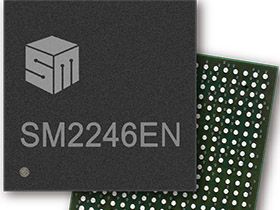
Ready For Something New In Solid-State Storage?
If you're a SSD manufacturer, you only have a certain number of options for building the next great drive. Take the controller, for example. Either you make your own or you take your chances with a third-party processor likes the ones from SandForce or Marvell. There's another promising contender in Link A Media Devices, or LAMD, which was acquired by the other enormous Korean company, SK Hynix. Now, if you want to use the SK Hynix/LAMD controller, you have to use the company's flash, too. So, that's one way to go, though it doesn't give you a ton of flexibility. Most of your remaining alternatives come from JMicron or Phison.

Why not just go the Marvell route? The company doesn't supply firmware for its controller, and apparently won't no matter what. That means you need a specialized firmware team, and that sort of talent doesn't just grow on trees. Meanwhile, SandForce is the opposite. It'll sell you a turnkey solution, but you don't really get many knobs or dials in terms of customization. Just a few features than can be enabled or disabled. Both are really awesome solutions, and they've found homes in some of the highest-profile SSDs on the planet.
Of course, there is always room for competition that's cheaper to buy, cheaper to implement, or armed with unique features. Maybe you want to go another route for differentiation's sake.
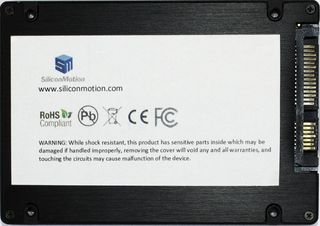
And that's what we have here.
Silicon Motion asked us if we wanted to take a look a one of its new controller designs. Called the SM2246EN, the Taiwanese company is hoping to add another option to the short list of real merchant SSD controller choices. And so, we were sent a reference processor and PCB platform to check out. We're always down to look at new stuff, especially when it's supposed to blow away the old stuff in one way or the other.
The SM2246EN is all about doing more with less. It's a four-channel design, manufactured on a 55 nm process, and equipped with just one core. SSD power consumption becomes more important every day, and Silicon Motion's design decisions appear motivated by trimming power as much as possible. If this approach pans out, it could become a serious alternative for a number of companies either building OEM solutions or channel-oriented SSDs. Silicon Motion doesn't manufacture drives. It makes the controller silicon. If you want, the company will sell you a PCB design, controller, and firmware, or just the controller, or some combination (though admittedly, snagging the firmware and PCB design doesn't make a ton of sense without a controller, but you get the point).
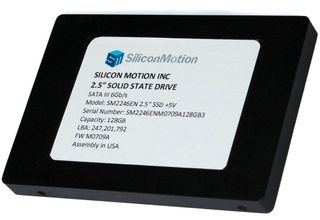
Silicon Motion is one of those companies you may have never heard of, but probably makes 12 things inside your office. It already has SSD processors in its portfolio, but most of its business is flash controllers for things like SD cards, CF cards, and USB-based storage devices. A smaller piece of its IP includes 3G and 4G LTE chipsets for Samsung devices running Android, but that seems like a business that probably has a bright future. Of course, SSDs are booming, too.
Stay on the Cutting Edge
Join the experts who read Tom's Hardware for the inside track on enthusiast PC tech news — and have for over 25 years. We'll send breaking news and in-depth reviews of CPUs, GPUs, AI, maker hardware and more straight to your inbox.

The Drive and Controller
As mentioned, Silicon Motion's SM2246EN controller is a four-channel design. We don't see many of those anymore. The most notable examples are probably Indilinx's Barefoot and Marvell's '9175 processors, the latter of which goes into SanDisk's Ultra Plus. Unlike much of the silicon we're accustomed to describing, this single-core, 32-bit, RISC-based design isn't based on an ARM architecture. The 12x12 mm package is instead ARC-based, similar to the licensed IP blocks in OCZ's latest BF3 controller series.
Emphasizing low power consumption isn't just a fad. Even desktop components are placing a higher importance on using less energy. With solid-state drives, this translates into more battery life on the road and lower cost of ownership in a data center. Especially in the mobile space, where ever-smaller form factors are requiring solid-state storage, Silicon Motion's focus on power could put it in a really strong position.
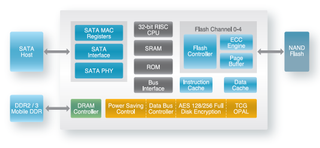
We don't want to make too big of a deal about the reference drive itself. You can't buy it, and there's a distinct possibility that you'll never see this exact configuration for sale. However, the drive we received was simply a PCB inside of a metal chassis, the SSD equivalent of a brown bag. Its labels are place holders. And that's fine with us; we love getting our hands on prototype gear whenever we can.
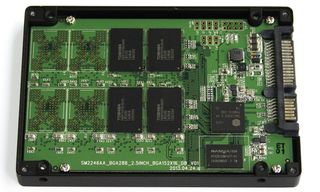
What you find on the inside is a bit more genuine, since Silicon Motion's controller has its own PCB design that partners can choose to use or not.
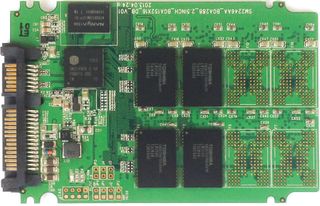
This particular drive is equipped with Toshiba's 19 nm eX2 Toggle-mode flash, which is some of the fastest NAND around. There are eight packages labeled TH58TEG7DDJBA4C, and each contains two 64 Gb dies. Above the controller you find a Nanya 128 MB DDR3 DRAM module for caching duties. And that's about it. Aside from the basic surface-mount components, there's not much else to see.
Current page: Ready For Something New In Solid-State Storage?
Next Page Test Setup And Benchmarks-
rolli59 Performance looks good, the question is with a new player on the market if it will affect market price to the benefit of users that have SSD boot/program drives up to 256GB.Reply -
4745454b While performance wasn't the best, it was more then acceptable. And then the power numbers looked great. Overall it's a great start. I'm interested in long term results as some controllers have had bugs in the past that have done bad things to people's data.Reply
And yes, great to see someone else enter in. While more players means you'll need to look harder at what SSD you are buying, at least we'll have the options. Which is always good, even if the options aren't as good as what you were hoping for. -
shin0bi272 Not that this isnt kinda cool but Taiwan is now part of China so its proper to call it China.Reply -
UmeNNis Reply11339051 said:Not that this isnt kinda cool but Taiwan is now part of China so its proper to call it China.
Ummm..... how exactly is "Taiwan now part of China"...?:sarcastic: -
mayankleoboy1 During the benchmarks, did you ensure that the Samsung EVO is not throttling due to high temps ?Reply
Maybe add a max temperature graph as well. -
e-z e Given time to mature this could be a real contender. Would love to see a follow-up once it hits the market.Reply -
zads Reply
If only this were the case, my job would be so much easier.11337088 said:Meanwhile, SandForce is the opposite. It'll sell you a turnkey solution, but you don't really get many knobs or dials in terms of customization.
